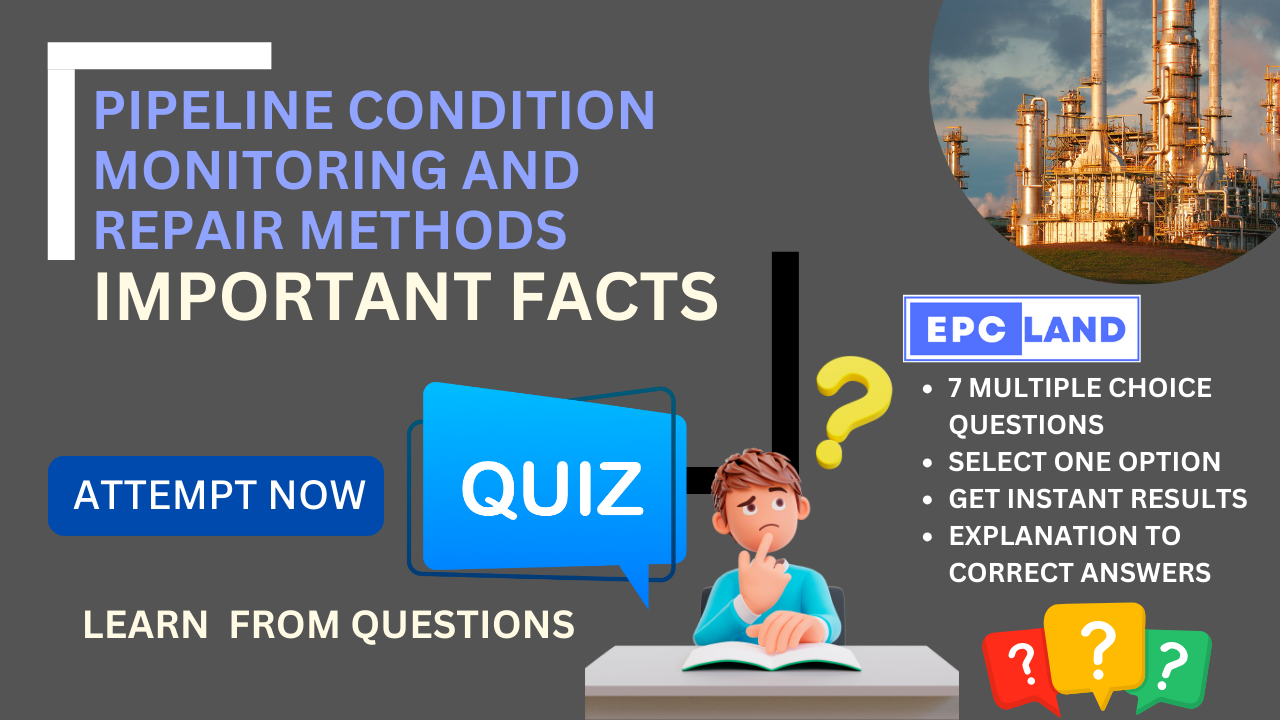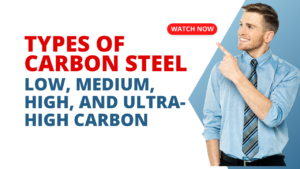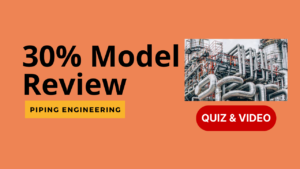1. Above-Ground Pipeline Condition Monitoring and Repair Methods
What are the primary objectives of above-ground Pipeline Condition Monitoring and Repair Methods?
Explanation: The primary objectives of above-ground pipeline monitoring include identifying cathodic protection ineffectiveness and detecting coating damage.
2. Common Above-Ground Pipeline Condition Monitoring and Repair Methods
Which above-ground monitoring method creates detailed maps of the pipeline’s magnetic field to identify anomalies?
Explanation: High-Resolution Magnetic Field Mapping (HRMF Mapping) creates detailed maps of the pipeline’s magnetic field to identify anomalies.
3. Underwater Pipeline Inspection
Which method emits acoustic signals to create a detailed image of the seabed and reveal the pipeline’s location?
Explanation: Side-Scan Survey emits acoustic signals to create a detailed image of the seabed and reveal the pipeline’s location.
4. Repair Method for Damaged Coatings
What repair method is employed for damaged pipeline coatings to restore the protective barrier against external corrosion?
Explanation: Coating Repair is employed for damaged pipeline coatings to restore the protective barrier against external corrosion.
5. Method for Assessing CP System Effectiveness
Which technique measures the electrical potential along the pipeline to assess the effectiveness of Cathodic Protection (CP)?
Explanation: Close-Interval Potential Surveys (CIPS) measure the electrical potential along the pipeline to assess the effectiveness of Cathodic Protection (CP).
6. Pipeline Rehabilitation Technique
What technique involves installing a new protective layer inside the existing pipeline to rehabilitate it?
Explanation: Pipeline Rehabilitation involves installing a new protective layer inside the existing pipeline to rehabilitate it.
7. Objective of Pipeline Monitoring and Repair
Why is implementing comprehensive pipeline condition monitoring and repair methods crucial?
Explanation: Implementing comprehensive pipeline condition monitoring and repair methods is crucial to minimize the risk of leaks, spills, and environmental damage.
Short Article on Pipeline Condition Monitoring and Repair Methods
Pipeline condition monitoring and repair methods play a crucial role in maintaining the integrity and safety of pipelines, ensuring the safe and reliable transportation of essential resources. These methods involve a combination of above-ground and underwater inspection techniques to detect and address potential issues before they escalate into major failures.
Above-Ground Pipeline Monitoring
Above-ground pipelines are readily accessible for inspection and monitoring, allowing for regular assessments of their condition. The primary objectives of above-ground pipeline monitoring include:
- Identifying Cathodic Protection (CP) Ineffectiveness:
CP systems are essential for preventing corrosion in buried pipelines. Above-ground monitoring techniques help identify areas where CP is ineffective, allowing for corrective measures to be implemented before corrosion occurs.
- Detecting Coating Damage:
Pipeline coatings provide a protective barrier against external corrosion. Above-ground monitoring techniques help detect coating damage, enabling timely repair and preventing corrosion from taking hold.
Common Above-Ground Monitoring Methods:
- Visual Inspection:
Visual inspection involves directly inspecting the pipeline surface for signs of damage, corrosion, or coating defects. This method is simple and effective for initial assessments.
- Close-Interval Potential Surveys (CIPS):
CIPS measure the electrical potential along the pipeline to assess the effectiveness of CP. Anomalies in potential indicate areas where CP is not adequately protecting the pipeline.
- Acoustic Leak Detection (ALD):
ALD systems utilize sensitive microphones to detect the sound of escaping fluid, indicating leaks or cracks in the pipeline.
- High-Resolution Magnetic Field Mapping (HRMF Mapping):
HRMF Mapping creates detailed maps of the pipeline’s magnetic field. Anomalies in the magnetic field can indicate the presence of corrosion or metal loss.
Underwater Pipeline Inspection
Inspecting underwater pipelines presents greater challenges due to limited access and visibility. However, several methods are employed to assess the condition of offshore pipelines:
- Side-Scan Survey:
Side-scan sonar emits acoustic signals to create a detailed image of the seabed, revealing the pipeline’s location, burial depth, and potential anomalies.
- Remotely Operated Vehicles (ROVs):
ROVs are equipped with cameras, sensors, and manipulators to conduct detailed underwater inspections. They can provide high-resolution images of the pipeline, identify defects, and collect samples for analysis.
- Visual Inspection Using Divers:
In shallow waters, divers can conduct visual inspections of the pipeline, providing detailed assessments of its condition and identifying potential defects.
- Intelligent Inspection Tools (IITs):
IITs are specialized tools that travel along the pipeline, collecting data on its condition. They can detect and measure defects, such as corrosion, cracks, and dents.
Repair Methods
Once defects are identified, appropriate repair methods are employed to restore the pipeline’s integrity and prevent further damage. Common repair methods include:
- Coating Repair:
Damaged coatings are repaired or replaced to restore the protective barrier against external corrosion.
- Cathodic Protection System (CP) Maintenance:
CP systems are maintained or upgraded to ensure they are effectively protecting the pipeline from corrosion.
- Pipeline Patching:
Small defects or leaks can be repaired using patches or sleeves that are welded onto the pipeline.
- Pipeline Replacement:
For severe or extensive damage, sections of the pipeline may need to be replaced with new pipe segments.
- Pipeline Rehabilitation:
In some cases, pipelines can be rehabilitated using techniques such as lining or relining, which involves installing a new protective layer inside the existing pipeline.
By implementing comprehensive pipeline condition monitoring and repair methods, pipeline operators can effectively manage pipeline integrity, ensure the safe transportation of resources, and minimize the risk of leaks, spills, and environmental damage.
Table of Contents
Don’t miss the Course on Effective Isometrics Management: Check Now
Enrollment Link
Recommended courses (Published on EPCLand)
- Complete Course on Piping Engineering
- Basics of Piping Engineering
- Piping Layout Engineering
- Piping Material Engineering
- Piping Stress Analysis
- Material Requisitions
- Piping Material Specifications
- Valve Material Specifications
- Plant Design & Layouts-OISD 118
- Isometric Management
Library of Technical Articles
Don’t miss out the collection of 15+ articles on following topics:
- Basics of Oil and Gas Industry
- Valves
- Testing
- Tank
- Piping Bulk Items
- Pipe
- Metallurgy
- Piping Materials
- Layout
- Instrumentation
- Heat Exchanger
- Type of Contracts
- Codes and Standards
- ASTM Standards
- Articles on Piping Specialty Items
Video details of Complete Course on Piping Engineering
Why Enroll in the EPCLand
Proven Track Record– PTR
Activities & Achievements before launching EPCLand
- Published more than 50+ short courses
- 3000+ Enrolments
- More than 3,500,00 Minutes of watch hours in the last 2 years
- 4000+ Students in 100+ Countries
- Rating of 4+ out of 5
- 1000+ YouTube Videos
- 8K+ Subscribers
What Students will Learn
- Codes & Standards of the Energy Sector
- Piping Material Engineering
- Piping Layout Engineering
- Stress Analysis
Interesting facts
- All the published courses have been developed by Industry Experts with more than 2 decades of experience
- Content is based on Practical experience and real-time problems.
- Content is designed and organized in such a manner that it can be easily grabbed.
- Complete website, Blogs and Quiz sections are Planned, Designed and published by myself (About me: Atul Singla)
- Complete flexibility of Time & Location, Students can access the content from anywhere & anytime
- Moreover, once enrolled, the content can be access as many times as you want, which helps in understand the fundamentals in a better way.
Conclusion
In conclusion, our courses are meticulously crafted by industry experts with over two decades of hands-on experience. The content is rooted in practical knowledge, addressing real-time problems. The material is thoughtfully designed and organized for easy comprehension. Every aspect, from the website to blogs and quizzes, has been planned, designed, and executed by Atul Singla, ensuring a comprehensive and seamless learning experience. With the flexibility of accessing the content at any time and from any location, students have the freedom to learn on their terms. Furthermore, enrollment grants unlimited access, allowing learners to revisit the material as often as needed, fostering a deep understanding of the fundamentals.



